Jeffrey Stark

@jeffreystark
About
Fredericton, NB, Canada
Known for:
Inclusive & Accessible Information and Communication Technology

Jeffrey Stark
@jeffreystarkPosts
CWDO Inclusive Testing Project – General Planning
note: This is a plain paste from the google docs planning document from the event:
Random Hacks of Kindness
CWDO Hackathon:
Involving PWD in Online Development
Inclusive Testing
Inclusive by design, accessible by default
For more information, see:
Jeffrey Stark
Inclusive Design Research Centre
idrc.ocadu.ca
-----
CWDO Hackathon: Involving PWD in Online Development
MAIN TASKS / WORKING GROUPS
Process / project management [Jeffrey, Daphne, Angelo, Martyna]
-
For now collect our information in Google docs, maybe later in Github
-
Develop lists of what needs to be done
-
Develop draft processes for company/organizations, users, accessibility users
-
Develop projected phases
Developing project content [Jeffrey, Daphne, Angelo, Martyna]
A. Developing content for forms: (initially google doc, maybe github later)
-
Collect info from organizations that require accessibility user testing
-
Collect info from users that can do testing
-
Collect info from accessibility ‘experts’ that organizations can hire to help make their content meet accessibility standards
-
Test/validate users’ ability to do certain kinds of ability testing
B. Developing other content for the site
-
About
-
Introductory or instructional text for each section of site
-
Contact us
C. Developing marketing content
-
Press release
-
Marketing introduction to project/service (text, possibly also video)
-
Post/send for organizations serving people with disabilities
-
Post/send for organizations seeking user accessibility testing
-
We Need Your Expertise and Help to break down barriers and help build virtual wheelchair ramps into the sites, services and systems of the future so everyone regardless of ability can get in through the door.
-
Platform and Module Set-up and testing [Michael, Larry, Ying, Eric, Dragan]
-
Research and develop accessible Drupal theme and modules that can achieve this kind of profiling
-
Dragan suggested a module
-
-
Get server running. Brett gets instance running?
-
How to interface UI with Drupal
-
How to test users’ abilities to do accessibility testing?
-
How does
-
Project members 2017-03-25
-
Angelo DeMarsico
-
Eric Mulligan
-
Larry Burge
-
Martyna Marjanska
-
Jeffery Stark
-
Cheng Giaoying
-
Michael Milette
-
Daphne Uras
-
Dragan Nevjestic
Projected Phases
-
PHASE ONE:
-
GOALS: Build English proof of concept for testing with computers, demonstrate demand, get basic workflow in place so can apply for funds for further development
-
Build prototype (using processes A and B) that allows
-
Testers to register
-
Companies to find testers
-
Testers to upload videos of their tests (records both the audio of the speaker and the video of the screen).
-
Provide some resources for building accessible web or mobile products
-
-
-
PHASE TWO:
-
GOALS: Using external funding (?), build larger scale and more automated version
-
Build version that can handle more testers, more company requests
-
Outsource payment system?
-
Make site bilingual
-
Expand resources for building accessible web or mobile and other products
-
Provide ability for WCAG experts to register in directory, so companies can find help (phase 2 or 3)
-
-
PHASE THREE
-
GOALS: Sustainable model that incorporates lessons learned from phase two, and expands testing environments
-
Build in extra features, eg coordinating companies with testers who are willing/able to work onsite
-
Permit testers to upload videos of their tests of mobile environments as well as computer environments: videos will also capture taps, swipes, and gestures
-
Further expand resources for building accessible web or mobile products if necessary
-
Provide ability for WCAG experts to register in directory, so companies can find help (phase 2 or 3)
-
-
PHASE FOUR (dream options)
User Process Maps
Process A: Tester Signup experience process map
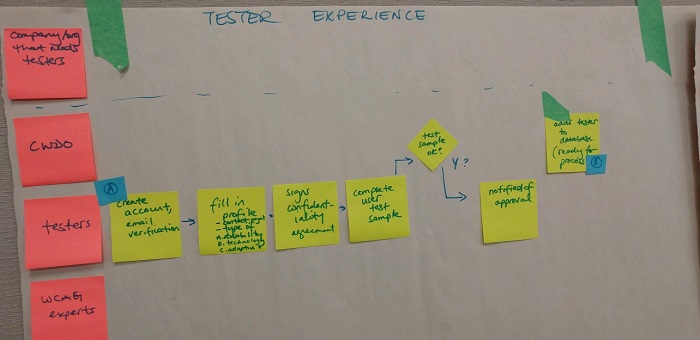
-
PHASE ONE
-
Register their testing abilities on site
-
Create account, email verification
-
Review technical requirements
-
Sign confidentiality agreement
-
Fill in profile (type of disability, technology, adaptive technology)
-
Do a sample test or multiple tests (tests are vetted by CWDO)
-
-
Process B: Company/organization experience process map

-
PHASE ONE
-
Company/organization registers
-
Company/organization posts a project and their requirements
-
For security reasons, project gets sent to CWDO administrator/group for approval/search
-
CWDO administrator/group finds appropriate testers
-
CWDO sends project description to potential testers
-
Testers can review material and indicate interest/availability to CWDO
-
CWDO sends user info to company
-
Company sends users content for testing
-
Testers upload their results (and notifies CWDO)
-
CWDO pays tester
-
-
PHASE TWO (after demonstrated success, something that can apply for funding)
-
System gets more automated to not require so much human handling and to let payment happen through site
-
Process C: WCAG Expert Signup experience process map
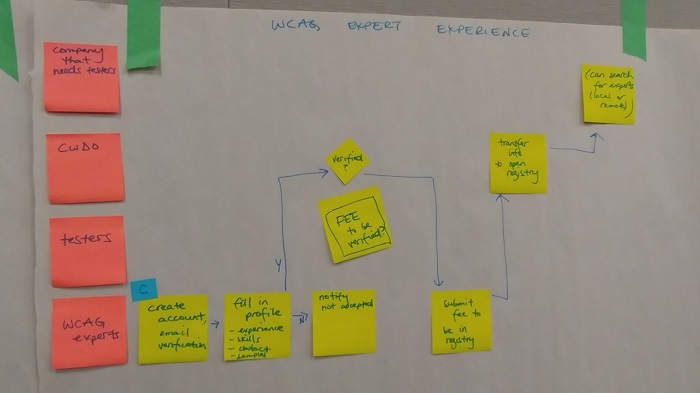
Proposed Website Structure
This is currently based on Usertesting.com’s structure, and should be reviewed and revised as necessary.
-
Home:
-
Inclusive Testing can help your company improve the usability, accessibility, and searchability of your web products. We match companies with people with disabilities, who will record 10-15 minute videos detailing their usability test of your website. For a low cost you can ensure that people with a variety of disabilities as well as search engines can find, navigate and use your content.
-
-
Log in: Allows registered company to enter the system
-
Company sign up: Allows a company to register (see Proposed Form Fields)
-
Get paid to test: Sign up form to become a tester. Two types of testers. People with disability and WCAG testers. (see Proposed Form Fields)
-
How it works:
-
Companies submit projects that CWDO disseminates to testers, who record their tests using screen recording software (length of the videos range between 10 and 15 minutes, depending on how many tasks the user is asked to do. Pro plans offers videos as long as an hour.)
-
Who uses us: Overview, Designers, Product Managers, marketers, Agencies, mobile Game Developers
-
Videos (sample, explanations)
-
FAQ
-
-
Resources: Overview, case studies, webinars, ebooks, white papers, tips and checklist, industry reports, our blog
-
About us: Overview, Executive team, in the news, contact us
-
Pricing: Request pricing details (call or email)
-
Help: Contact us form, FAQ
Proposed Devices Requirements:
These requirements are subject to revision; they will depend on the video testing tool.
Either a PC or Mac that meets these requirements:
- PC
- Operating system: Windows 7, 8 or 10.
- Memory: At least 1 GB of total RAM and 0.5 GB of available RAM.
- Free disk space: At least 7 GB of free disk space.
- Browser: Internet Explorer 11, Firefox 45, or Chrome 49.
- Mac
- Operating system: OS X 10.7 or higher
- Memory: At least 1 GB of total RAM and 0.5 GB of available RAM.
- Free disk space: At least 7 GB of free disk space.
- Browser: Firefox 45, Safari 8, or Chrome 49.
- For mobile tests, you need an Android or iOS mobile phone or tablet. Sign up first to be a desktop tester, and then you can add mobile testing.
For mobile tests, your device will need to meet these requirements:
- iOS
- Operating system: iOS 8 or higher
- Memory: At least 400MB of free space.
- Android
- Operating system: Android OS 5.0 or higher
- Memory: At least 400MB of available space on your device and 20% battery life when you try to take a test.
-
Microphone, example
-
Screen recorder, administrator’s access is required to install the software on the computer. Some free choices are listed here: http://download.cnet.com/s/video-record-capture/windows/?tag=bc. Maybe this one which is free could be used for the purpose of this exercise: http://download.cnet.com/Apowersoft-Free-Screen-Recorder/3000-13633_4-75959899.html. It may only work for windows OS: Windows XP/2003/Vista/7/8/10
-
PayPal account, to get paid.
Proposed Form Fields
Company Sign Up Form
Choose type of organization:
-
Individual
-
Non-profit/charitable
-
Enterprise
Registration form:
- First name
- Last name
- Work email
- Phone number
- Company name
- Password
- Password again
Registration form for disability user tester
- First name
- Last name
- Email address
- Phone number
- Company name
- Address
- Language preference
- Category of disability > vision, hearing, physical, cognitive/learning style
- Primary device -pc, mac, android, ios
- Technical level of knowledge… i.e. intermediate pc user
- Description of disability
- Description of Adaptive technology on primary computer/device
- Other devices
- Other adaptive technologies or options
- Are you willing to travel to testing location?
- Password
- Password again
- Qualifying test:
- Vision – video, audio
- Physical – video, stop video, make notes
- Cognitive – video, audio
- Hearing – video, stop and make notes
- Learning style – video, audio
Registration form for WCAG tester
- First name
- Last name
- Work email
- Phone number
- Company name
- Level of WCAG knowledge
- Password
- Password again
- Qualifying test: send WCAG test to evaluate
Accessibility Resources for site
-
Inclusive Design Research Centre: http://idrc.ocadu.ca/
-
Ontario Accessibility Laws: https://www.ontario.ca/page/accessibility-laws
-
WCAG 2.0 Quick Reference: https://www.w3.org/WAI/WCAG20/quickref/
-
WCAG Before and After site: https://www.w3.org/WAI/demos/bad/Overview.html
-
Tool – WAVE: http://wave.webaim.org/
-
Tool – Colour Contrast Analyzer: https://www.paciellogroup.com/resources/contrastanalyser/
-
Tool – NVDA (screen reader): http://www.nvaccess.org/
-
Tool – PX to EM conversion: http://pxtoem.com/
-
Tool – PDF Accessibility Checker (PAC 2): http://www.access-for-all.ch/en/pdf-lab/pdf-accessibility-checker-pac.html
-
Tool – Subtitle Horse Online Subtitle/Caption Editor: http://subtitle-horse.com/
-
Tool – W3C Feed Validator Service: https://validator.w3.org/feed/
-
Tool – W3C CSS Validation Service: https://jigsaw.w3.org/css-validator/
-
Tool – W3C HTML Markup Validation Service: https://validator.w3.org/
-
Tool – W3C Link Checker: https://validator.w3.org/checklink
Random Hacks of Kindness
CWDO Hackathon:
Inclusive Testing
Inclusive by design, accessible by default
Jeffrey Stark
Inclusive Design Research Centre
idrc.ocadu.ca
Questions?
Thank you to our RHoK team this weekend
- Angelo Demarsico
- Cheng Qiaoyining
- Daphne Uras
- Eric Mulligan
- Jeffery Stark
- Larry Burge
- Martyna Marjanska
- Michael Milette
Finally: High Contrast Black On Android (Root Required)
If you have low vision or difficulty seeing screens with a white background and find invert to be ineffective, there may be a really good reason to root your android phone.
Substratum Theme Engine (root):
Substratum is a system based on Sony's Overlay Manager Service and the Layers project.
In Practical terms what this provides is a method of forcing a dark theme into apps without needing to install a seperate dark app as was done with the BlackOut offering a few years ago. Nor do you need to install a custom ROM, as is needed in order to use the now defunct CyanogenMod Theme Engine.
With substratum installed, you can apply a theme to the apps and UI of the phone. A good high contrast theme is Swift Black Substratum Theme.
Screenshots
Here are some sample of Swift Black Theme:
Screenshot 1: Gmail
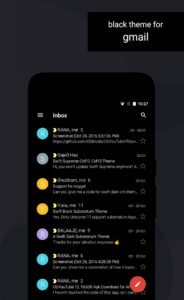
Screenshot 2: Settings
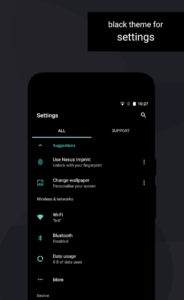
Screenshot 3: Allo
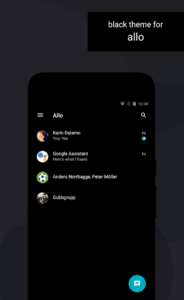
Screenshot 4: Google Now
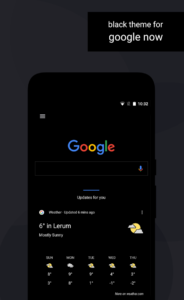
Some examples of supported apps within this theme:
- Calculator
- Chrome
- Chrome Beta
- Chrome Dev
- Contacts
- Dialer
- Documents/Downloads
- Dropbox
- ES File Explorer
- Facebook Messenger
- FB Messenger Lite
- Gmail
- Google Allo
- Google Assistant
- Google Authenticator
- Google Calendar
- Google Dialer
- Google Docs
- Google Drive
- Google Home
- Google Keyboard
- Google Maps
- Google Messenger
- Google Music
- Google Now
- Google Plus
- Google Translate
- GroupMe
- Hangouts
- Inbox
- JuiceSSH
- Keep
- Kik
- Magisk
- Nova Launcher
- Omni
- Pushbullet
- Root Explorer
- Settings
- Skype
- Slack
- SuperSU
- System UI
- YouTube
- …and more
Getting It Done
I have personally tried this on 2 phones so far. From the reading I have done, it works best on devices that run the stock version of android. The more modifications to the stock the larger the chance this will not work. I know it works on the Oneplus +1 running Lineage and the Pixel.
I cannot stress this further, but doing this will forever void your manufacturer warranty. While you will still have insurance through your carrier if you have purchased it, Your device's support centers will not be able to help you.
For help rooting your phone check out Rooting The Pixel and How To Root Your Android Device As A Blind Person
For help installing the Substratum Theme Engine Check out the Guide to installing substratum theme engine
Project Proposal – Linking People With Disabilities Into Development (draft)
Project Proposal For Random Hacks of Kindness – https://rhok.ca/
Ottawa – March 24-26
RHK matches up organisations that have a social impact, with skilled technologists who want to make a difference, to develop open-source solutions to the challenges facing society
Citizens with Disabilities – Ontario
RHOK Project – Linking People With Disabilities Into Development Activities
Organisation
Citizens with Disabilities – Ontario (CWDO) is a small non-profit organization of volunteers that actively promotes the rights, freedoms and responsibilities of persons with disabilities through community development, social action, and member support and referral. Our primary activity is public education and awareness about the social and physical barriers that prevent the full inclusion of persons with disabilities and has over 2,000 members from across Ontario .
CWDO is proud to be a full member of the Council of Canadians with Disabilities. CCD is a national human rights organization of people with disabilities working for an accessible and inclusive Canada
People With Disabilities
Disability is a broad term that describes a physical, mental, sensory or cognitive condition that may limit full participation in life due to environmental or social barriers
- Around 15 per cent of the world’s population, or more than 1 billion people, live with a disability. 1 They are the world’s largest minority 2 , and the only minority group any of us can become a member of at any time.
- Worldwide, 40% of people have a person with a disability in their immediate circle of friends and family.
- In 2006 14.3% of Canadians had a disability 6 . That is one in seven Canadians.
In Canada We Are All Online
- Applying for jobs, communicating with friends and family, dating, participating in online classes, shopping, accessing services, researching class projects, buying concert tickets, banking, working online or with online systems and doing many other activities.
- People With Disabilities Are Online Too
Closed Doors
- Even when people with disabilities have access to the most advanced and expensive technology the sites, services, apps and content need to be designed with the virtual wheelchair ramps necessary to get in the door.
- According To The Business Disability Forum 70% of sites tested lack even basic accessibility
The Community Of People With Disabilities
Digital inclusion can be broken down into four key categories
1.Visual
- Vision Enhancement and Replacement Tools, Techniques and Technologies
- This can be non-sighted users, users with low-vision, users with obstructed vision, or even simply your aging parents. (e.g. Myopia, Colour blindness, Glaucoma, Albinism)
2.Auditory
- Audio Enhancement and Replacement Tools, Techniques and Technology Users
- This can be deaf or deafened users, users who are hard of hearing, or even simply your aging parents. (e.g. Tinnitus , Presbycusis, Acoustic trauma, Auditory processing disorder, Otosclerosis)
3.Mobility and Dexterity
- Mobility and Dexterity Enhancement Tools, Techniques and Technologies
- People with physical impairments typically use a wide range of techniques from those that replace a keyboard, mouse or touchscreen to technologies ranging from specialized keyboards, to eye trackers, to using single buttons to navigate their device .(e.g. RSI, Cerebral palsy, Parkinson's, Muscular dystrophy)
4.Cognitive and Learning Style
- Cognitive and Learning Style Enhancement Tools, Techniques and Technology Users
- Relates to the need to consume or interact with information using different channels, methods or the ease processing of information. (e.g. Dysgraphia, Dyslexia, Down’s syndrome, Autism, Global developmental delay)
The Problem We Are Attempting To Solve
In Canada, there is a need for connecting people with disabilities willing to do user testing with people looking for user testing.
Small, medium and non-profit organisations are generally lacking the connections or understanding to ensure that their sites are usable by people with disabilities. It is not easy to find or request a group of people with a wide range of disabilities to try out some new prototype or system.
The Idea On How To Solve It
It is our thought that people would be more willing to do user testing if offered a small financial compensation for their time. It is our thought that If it were easy to request a group of people to try out some new prototype or system, it could encourage developers to test earlier in the process or integrate inclusive design principles earlier in the process. This can help people find problems earlier or easier.
- What is being proposed is that a system be developed similar in concept to: User Testing Dot Com. The site Facilitates the interaction. Gathers people, tags their skills, competencies & technology usage. Ensure French and english testers are identified. Post projects or requests and have a pool of people be offered the testing.
The call to action
We Need Your Expertise and Help to break down barriers and help build virtual wheelchair ramps into the sites, services and systems of the future so everyone regardless of ability can get in through the door.
if we build it… will they come?
Hackathon Project …
So here is the question, if we build it… will they come?
In Canada, Is there a need for connecting people with disabilities willing to do user testing with people looking for user testing? It is our thought that people would be more willing to do user testing if offered a small financial compensation for their time. It is our thought that small, medium and non-profit organisations are generally lacking the connections or understanding to ensure that their sites are usable by people with disabilities. If it were easy to request a group of people to try out some new prototype or system, would this encourage developers to test earlier in the process or integrate inclusive design principles earlier in the process. Would this help people find problems earlier or easier?
What is being proposed is that during an upcoming Hackathon, that a system be developed similar in concept to: User Testing Dot Com
That Facilitates the interraction. Gather people, tag their skills, competencies & technology usage.
Ensure french and english testers are identified. Post projects or requests and have a pool of people be offered the testing.
This is a proposed project for Random Hacks of Kindness
Ottawa – March 24-26
RHK matches up organisations that have a social impact,
with skilled technologists who want to make a difference,
to develop open-source solutions to the challenges facing society
What do you think?
Travelling as A Blind Uber Rider in Canada
For those who have been unsure about trying out Uber or how well it works. I want to assure you that it is a fantastic service. As a blind person, I don’t drive and therefore only have public transit, taxis and the good will of others as transport options. It is great to have other choices. Signing up was straight forward and like any other app. There is an Uber app for both iOS and Android. Both are accessible if not intuitive.
I have used Uber a dozen or so times this year. I can’t speak to guide dog access but I have had extremely excellent service every time.
There are 3 categories of Uber in Ottawa
, the city I live in:
- Uber X = standard Uber
- Uber XL = van
- Uber Assist = Uber X + someone who has received mandatory disability training and gets paid more by Uber to be helpful and accommodating (even though the customer pays the same rate of a standard Uber request / an Uber X)
To give you a sense of the cost of Uber vs Taxi service. It’s a $50-60 taxi charge to go from downtown to Kanata, it’s $24 to take an Uber there.
The process for ordering an Uber is as follows (text might not be “exact” but should be close):
- On iOS or Android load the Uber app
- Click the Uber Assist tab
- Select get estimate
- Enter your destination and select it in the search results
- Verify cost and pickup destination address
- Select request Uber
- Confirm you have a disability by selecting “confirm”
- Confirm the trip by clicking request
You will be sent at least 2 notifications, 1 right after booking that contains the time to arrival and another notification when the driver is pulling in
You may also get text messages or called if the driver has difficulty finding you
After the drive, open the app and rate the driver on a 5 point scale.
If he gets several low scores; he will lose his ability to do Uber assist.
I even did Uber when coming home from the AEBC AGM and took a bus that arrived at the downtown bus station at 3am. I ordered an Uber assist at 3am, I was at the wrong door, he called me and came out and found me, escorted me to his car and was very friendly and helpful.
I would highly recommend Uber
Toronto Tourism For Families With A Blind Member
In my family there are 2 blind members, 1 adult and 1 13year old girl. When the family was planning a trip to Toronto we really didn’t know where to start. A quick google for things that would be. Of interest for Blind Tourists yielded pretty much nothing and a visit to the Toronto Tourist Bureau website was equally as unenlightening.
So I decided to leverage my contacts of people with disabilities in the Toronto community and came back with a wealth of information. Tracy and Ian to the rescue.
I am sure, following my visit, I will update this article as I find more things to do and maybe report on my experiences at these establishments or activities.
- The new Tangled Arts Gallery at Richmond & Spadina; small gallery space with exhibitions by disabled artists, fully accessible curatorial practices; check www.tangledarts.org for what's on.
- The Art Gallery of Ontario has 'Full Sensory Tours' guided by trained volunteers which permits tactile examination of selected works and extremely verbal description of many of the works in the collection. Contact Melissa Smith at [email protected] To set up a tour.
- If outdoors is your thing, I'd recommend joining a Safari Walk through the City's parks & ravines, every Thursday morning from 10am to about noon, and usually followed by lunch at a nearby pub. Contact Craig at [email protected] For more info.
- If you like bike riding, you can talk to Trailblazers Tandem Cycling to match you up with a sighted 'captain' who will steer the bike while you peddle from the rear position. http://torontotrailblazers.org/ Contact Lynda Spinney at [email protected]
- The CCB Toronto Visionaries have made arrangements for walking tours of various neighbourhoods (Kensington Market, St Lawrence Market-Old Toronto-the Distillery District) through an organization called 'TAP into Toronto', which matches up interested people with a volunteer guide who will point out interesting features, allow you to sample the wares of various retailers, highlight points of historical interest, etc. You can contact TAP through Jamie Maxwell at 416-338-0029 to set up a tour.
- the Royal Ontario Museum (ROM) has audio tours and 3-D touchables in some galleries for people who are blind. If you have any questions or comments regarding accessibility at the Museum, or for more information, please contact: Audience Coordinator, Royal Ontario Museum Tel: 416.586.5823 or E-mail: [email protected]. Ask if a volunteer could do a guided tour. Access2Entertainment card is honoured and service animals are allowed. They have several digital audio descriptions that can be downloaded. They will also do audio tours with three weeks notice. If you want to do this, call them right away. I spoke with Jaclyn.
- I was told “It's wacky but I hear rave reviews about the Bata Shoe Museum”. They have a streaming audio guide for all galleries. It's a short walk from the ROM. Contact visitor services at 416-979-7799 extension 240 or email [email protected]. You might be able to request a tour but I don't know if it has to be a big group. To book a tour please contact Andrea Field, Education Coordinator at 416-979-7799 extension 242 or email [email protected].
- Harbourfront has lots of activities – some free, with music and performances. Accessible tours of our site or galleries can be arranged with advance notice and consultation with our staff at the Information Desk. Our courses and workshops can be arranged to best serve the needs of all of our patrons with advance notice and consultation with registration staff in the specific departments or areas. General enquiries (416) 973-4000 or [email protected].
- In the Harbourfront area there's the Disabled Sailing Association of Ontario (DSAO). It is dedicated to providing people living with a disability the opportunity to learn about and enjoy sailing. The DSAO is a non-profit charitable organization founded, organized and run by people with disabilities, and is uniquely attuned to the needs and desires of its participants. Call 416-214-0358 to find out if you could book a sessionnot sure if they'll do a one off.
- Blind sailing out of Toronto Harbour allows for blind and partially sighted people to have a go at actively sailing a 27-foot sailboat under the supervision of a sighted volunteer captain and crew, or just relax and enjoy the ride. Contact Grant Robinson or anyone at Blind Sailing Association of Canada, http://blindsailing.ca/contact/
- Blind sailing out of Toronto Harbour allows for blind and partially sighted people to have a go at actively sailing a 27-foot sailboat under the supervision of a sighted volunteer captain and crew, or just relax and enjoy the ride. Contact Grant Robinson or anyone at Blind Sailing Association of Canada, http://blindsailing.ca/contact/
- The Toronto Zoo is huge and amazing and will arrange a volunteer tour for anyone with a service animal if contacted at least one week ahead of time. A volunteer guide will always accompany guests who bring service animals. Service animals are not permitted in certain areas, e.g., aviaries. The gorillas are very interested in them, though, so that's pretty cool. More information about service animals at the zoo is available on the zoo website. I think a tour can also be arranged for you, even if you do not use a service animal. There is a children's area inside where petting is allowed and there are lots of areas for interaction. In fact, interactive and touchable tables are spread in various places around the zoo which are staffed by volunteers who are very knowledgeable and can answer lots of questions. There is a cool off splash zone near the children's zoo, so bring a swimsuit. Call visitor services at 416-392-5942 at least a week ahead of time,
- Ben Knoop, our head of exhibitry, writes:
- I would suggest visiting as soon as the Zoo opens when the animals are most active. Sometimes the animals are making noises at that time of the day. I've heard the lions roaring and the wolves howling early some mornings.
- They could also check out some of our exhibits where we have more vocal animals (watusi, bald eagle, monkeys in Americas, kookaburra, flamingo, various other birds). The electric eel in Americas has a speaker that plays a sound every time the eel lets out a shock. Sometimes the baby polar bear makes a lot of noise – usually first thing in the morning.
- Don't forget that some animals have quite the smell too! I'm thinking of the gorillas, the primate wing in Americas, the Indian rhino, and the hippo to name a few.
- They could attend the show at Waterside Theatre or various keeper talks around the site to learn more about the animals.
- Volunteers around site have touch tables set up with animal bones, skulls, and pelts that they could feel.
- Just a note, we have a specific policy for service dogs just in case they use one: http://www.torontozoo.com/ExploretheZoo/Accessibility.asp?pg=ServiceDogs
- And our Outreach supervisor Karen Hamilton adds:
- Added to Ben's excellent suggestions, I would also like to suggest the Free Flight Aviaries might be of interest. All of the pavilions have at least one, and there is also an outdoor one in the KidZoo. In the free flights the guest is immersed in the environment with the animals, including the plants from that region. So the sounds of the birds vocalizing and flying and the smells of the flowers, etc. are all around them without barriers. No sight required.
- The animal show that Ben mentions is also good. At the end of the show, the Keepers bring out some of the show animals for close encounters with guests – right in the arena. This provides an opportunity to talk to a Keeper, and also perhaps touch some of the animals suitable for that purpose. This is open for everyone, so no special treatment.
- The KidZoo may also be a good suggestion, as there are animals that the guests can touch if the animals choose to be close to the fence, like the goats and rabbits. There is also a Backyard Kiosk there which always has touchables and staff or volunteers to speak with. The Keepers in the KidZoo do many unscheduled encounters as well, where they will bring a skunk or ferret, etc. out of their enclosure for up close and touchable experiences.
- There are also many Casual Encounters that take place throughout the day randomly on site that they could run into. For these, Keepers will be out on public pathways with suitable animals so that guests can meet them and talk to their Keepers.
- Throughout the Zoo there are also many static exhibit features or extras that can be explored, such as the dug out canoe in the African Rainforest, the termite mounds in the Savanna, the mosquito tunnel in Tundra Trek, the video talks at Gorillas and the Education building, and the animal statues/sculptures in many locations that are touchable.
- Ben Knoop, our head of exhibitry, writes:
- If you like music, there are free concerts in the evenings at the gorgeous and fragrant Toronto Botanical Gardens as part of their Summer of Song series. Read the lineup for Summer of Song.
- Downtown at Yonge/Dundas Square there is the free Indie Fridays music festival on Fridays at 8:00 PM throughout the summer.
- Outdoor performances of Shakespeare in High Park have been an annual event for decades and are excellent. Adults $25 and children under 14 are free. Recommend you bring a blanket and mosquito repellent since performances are totally out doors and begin at 8:00 pm. For more information call 416-368-3110.
- If you like rides, and it is possible to get a little bit outside the city, you may want to try Canada's Wonderland. Canada's Wonderland has braille and large print guides available from the Front Gate Guest Service on a first-come, first-served basis. They will hold onto your ID until you return the guide at the end of your visit. Service animals are permitted on the grounds, but only on a couple of very gentle rides. They have a parent swap policy whereby someone can watch or animal while you are on a ride. In addition to rides, they have a number of theaters that can be very entertaining. They are a bit expensive, though, so you may not want to go unless there is a lot you would be able to do there. Contact Guest and Information Services at the Front Gate or in KidZville while at the Park, or call 905-832-8131 before your visit to have specific questions and find out their pricing policy for guests with disabilities.
- About Toronto public transit – the TTC – All buses and subways have audio feedback, plus priority seating. Streetcars are in transition so old cars have no audio. You can buy a pass for a month, week, or a day which would give you unlimited trips for that time period. Anything downtown – it may be best to take TTC.
Session Notes: Android Accessibility Walk Through
Android Accessibility Walk Through
Presented By Jeffrey D. Stark
Workshop presented At the CCB Halifax Conference on Low Cost Solutions For People Who Are Blind Or Have Low Vision
Vision & Android
Android supports features for Sight, Sound, Physical & Cognitive Digital Inclusion for people with disabilities. This session will cover vision related topics and features.
The Basics
tremendous amount of customisation available, you can customize your device and make many different changes: For example, You can disable lock screen and you can change the home screen. There are choices for Text to Speech. The way you interact with an android device’s screen reader and magnification gestures are similar but not exactly the same as iphones. i.e. in android talkback, you use 2 fingers to scroll pages/lists instead of 3 fingers to scroll. All gestures and keyboard commands can be changed if you prefer or need access to specific commands. See the following audio tutorial for an example of a usage for this and how to do it:: http://inclusiveandroid.com/content/customising-talkback-gestures-quicker-web-navigation
The Devices
-
There are countless devices from the $50 remix mini to the BrailleNoteTouch. From small screen smart phones to 20+ inch tablets.
-
Some good starters:
-
Samsung Galaxy S5, S6, S7, the Blackberry Priv, with a physical keypad, the Oneplus1, the Motorola MotoX. These phones have different shapes, sizes, expandability (i.e. SD card slots) or physical buttons/keypads.
-
The Doro phone is offered by bell for $49 and contains physical keys and an interface for those wishing a simpler phone (who might at some later point want to explore android more fully later) – http://www.bell.ca/Mobility/Products/Doro-824
-
Accessibility Features:
- Screen Magnification support is great on android
- Screen reader is on par with other OS(s)
- Braille support on android devices is not as good as on idevices, but is scheduled for a major update this year.
- Exception: Mobile Accessibility Suite & Braille Notetakers
- Phones that run a specific version of Android called CyanogenMod(i.e. the OnePlus 1 that Jeff uses) support much more customisation such as custom themes to enable a fully high contrast black experience for low vision users without the need to invert the screen colors of other items like photos of people or videos
Getting Started
-
Hold 2 fingers slightly apart on the screen for 10 seconds and Talkback will load
-
Basic Concepts Of Android
-
Launcher
-
Desktop / workspaces
-
Dock
-
Apps Drawer
-
Notification Area
-
Quick Settings
Resource For Accesible Apps, Tutorials & Audio Walkthroughs
http://inclusiveandroid.com
- Inclusive Android Community Site: Share your information, ideas, apps and tips with the community of people with disabilities who are Android users from across the world! Information To Promote Sight, Sound, Physical & Cognitive Digital Inclusion for people with disabilities
InclusiveAndroid.com: Getting Started
-
If you are just starting out with android there are a ton of Guides to help you get started on Android
-
Also a number of community members have recorded many
-
Audio Tips And Tutorials. In particular, if you are just starting out, the
-
demystifying Series Of Audio Tips From Sebastien, the walkthrough for using Google Now or OK Google From Warren the walkthrough of the initial setup on stock android plus factory resetting an old device from Quentin and the walkthrough on Enabling Talkback On Samsung A3 from Alan are excellent audio tips for a new user.
InclusiveAndroid.com: Apps Directory
-
Collections of apps from polls:
-
Results Of The 2015 Favourite Accessible Android Assistant Software Poll
-
Results Of The December 2014 Favourite Accessible PodcatcherPoll
-
Results Of 2016 Poll – Favourite Accessible Android Email Client
-
Poll Results: Favourite Text To Speech Engine
-
-
You could also find out what apps I have installed on my phone in the article: List Of App Recommendations For Blind And Partially SightedAndroidUsers
-
maybe you are looking for something fun to do, you can check out the Accessible app directory's Game Section
Apps For Specific Disabilities, Limitations or types of barriers
- If you are looking for something to remove a specific barrier, a perfect tool or something made with a specific disability in mind, you could check out the following App Directory Sections:
- Apps Designed Specifically For Blind And Low Vision Users
- Apps Designed Specifically For Deaf And Hard Of Hearing Users
- Apps Designed Specifically For Users With LD Or Cognitive Requirements
- Apps Designed Specifically For Users With Physical or Dexterity Requirements
Screen Readers On Android
-
Several choices of Screen readers:
-
Mobile Accessibility
-
Provided free for bell customers
-
Better braille support than currently offered natively on android (on par with iOS)
-
-
-
Talkback (by Google)
-
Shine Plus
-
Samsung Voice Assist
-
Text To Speech Engines are installed in the Operating System and are useable everywhere in all apps without having to purchase for each app. Lots of voices and text to speech engines available:
-
Eloquence TTS
-
Acapella TTS
-
Samsung TTS
-
ReadspeakVocalizer TTS
-
IvonaTTS
-
Google TTS
-
Standard Apps
-
Google Now
-
Can be used as an assistant but really more intended for push notifications and telling you things before you ask – http://blog.blackspheretech.com/?p=175 Used for everything
-
-
Google On-Tap
-
Accessible Browsers:
-
Chrome
-
Firefox
-
Samsung Browser
-
-
•Email
-
Gmail
-
Inbox
-
Aquamail– connect many mailboxes
-
-
Dropbox / Googledrive/ onedrive
Some useful apps:
-
Books & Audio
-
@voice aloud reader
-
Smart audiobook player
-
Listen audiobook player
-
cnibdirect to player app, file management
-
goreadfor bookshare
-
voice dream available but not as needed on Android because of it’s open system – many other apps that do the same thing as voice dream – i.e. pdf to speech pro, voice aloud reader and go read
-
-
Social Media
-
Tweetingsfor Twitter
-
Standard Facebook app is accessible
-
-
Camera BsedApps
-
KNFB Reader delivers good OCR results to take a picture and read out text
-
TapTapC– object identification
-
More useful apps:
-
Music:& Podcasts
-
Music folder player
-
Gone mad music player
-
Google play music (subscription – like songza/spotify/groove/apple music
-
Podcast addict
-
Antenna Pod
-
CBC One – stream or download
-
-
Tools
-
Total commander – file management like windows explorer and can Access windows – shared drive
-
-
GPS blindness specific apps:
-
Nearby Explorer has both a free and paid version,
-
Notnav
-
Getthere
-
Peripherals
-
USB OTG Cable
-
USB Keys with USB Micro Adapters
-
External Keyboards
-
ChromeCastDongles
Other Resources
-
Official Android Accessibility Help:
-
Directory Of Forums and mailing lists that cover Disability and Android
-
List Of App Recommendations For Blind And Partially Sighted Android Users
Questions and Answers
Contact Information:
Email: [email protected]
Info: http://about.me/jeffreystark
Blog: http://blog.blackspheretech.com
About
Fredericton, NB, Canada
Known for:
Inclusive & Accessible Information and Communication Technology
